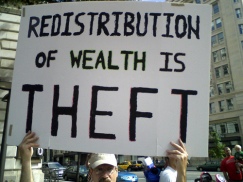U.N. Official: Climate Issue is for Wealth Redistribution
November 25, 2010 1 Comment
by Raven Clabough
Assertions made by climate-change skeptics that there are ulterior motives behind climate-change legislation were confirmed by a leading member of the United Nations Intergovernmental Panel on Climate Change (IPCC). 
During an interview with Germany’s NZZ Online Sunday, UN official Ottmar Edenhofer declared, “We redistribute de facto the world’s wealth by climate policy.”
The interview went as follows:
(NZZ AM SONNTAG): The new thing about your proposal for a Global Deal is the stress on the importance of development policy for climate policy. Until now, many think of aid when they hear development policies.
(OTTMAR EDENHOFER, UN IPCC OFFICIAL): That will change immediately if global emission rights are distributed. If this happens, on a per capital basis, then Africa will be the big winner, and huge amounts of money will flow there. This will have enormous implications for development policy. And it will raise the question if these countries can deal responsibly with so much money at all.
(NZZ): That does not sound anymore like the climate policy that we know.
(EDENHOFER): Basically it’s a big mistake to discuss climate policy separately from the major themes of globalization. The climate summit in Cancun at the end of the month is not a climate conference, but one of the largest economic conferences since the Second World War. Why? Because we have 11,000 gigatons of carbon in the coal reserves in the soil under our feet — and we must emit only 400 gigatons in the atmosphere if we want to keep the 2-degree target. 11,000 to 400 — there is no getting around the fact that most of the fossil reserves must remain in the soil.
(NZZ): De facto, this means an expropriation of the countries with natural resources. This leads to a very different development from that which has been triggered by development policy.
(EDENHOFER): First of all, developed countries have basically expropriated the atmosphere of the world community. But one must say clearly that we redistribute de facto the world’s wealth by climate policy. Obviously, the owners of coal and oil will not be enthusiastic about this. One has to free oneself from the illusion that international climate policy is environmental policy. This has almost nothing to do with the environmental policy anymore, with problems such as deforestation or the ozone hole.
The Media Research Center reports that Edenhofer was “co-chair of the IPCC’s Working Group III, and a lead author of the IPCC’s Fourth Assessment Report released in 2007 which controversially concluded, “Most of the observed increase in global average temperatures since the mid-20th century is very likely due to the observed increase in anthropogenic greenhouse gas concentrations.”
Edenhofer confirmed what many Americans have asserted all along: cap and trade will penalize Americans and American industry. The American Chronicle article entitled “Cap-and-Trade Energy Tax will Cause Redistribution of Wealth Among States and Working Families” cites the Congressional Budget Office as stating that cap and trade would cost the average American household an extra $1,600 per year. It would increase the price for a gallon of gasoline between $0.61 to $2.53, and would increase electricity costs anywhere from 44 percent to 129 percent.
In 2009, Our Changing Globe wrote of cap and trade: “The intention is that the industrial world would pay the underdeveloped world huge sums of money for doing nothing at all, and you can easily imagine the bureaucracy and corruption that would occur if this nonsense were ever to come into being.”
It added, “The flawed idea behind Cap and Trade is that companies that were penalized would work hard to reduce their pollution, and even though the technology is presently not available and won’t be in the foreseeable future, Obama is promising that the U.S. will reduce its pollution by 80 percent, which would take it back to levels that existed before the industrial revolution.”
Evidence of this plot for the world’s wealth redistribution dates back as far as 1990, when Maurice Strong, head of the United Nations Environmental Program, suggested this scenario: “What if a small group of these world leaders were to conclude that the principle [sic] risk to the earth comes from the actions of the rich countries? In order to save the planet, the group decides: Isn’t it the only hope for the planet that the industrialized civilizations collapse? Isn’t it our responsibility to bring this about?” Strong allegedly posed this scenario as a speculative plot for a novel that he considered writing, though he has never penned a novel in his life, either before or after 1990.
Today, progressives and Marxists have seized upon claims that the planet is in peril in order to negotiate cap-and-trade and climate change policies. Through the formation of the Chicago Climate Exchange, coupled with the potential passage of the cap-and-trade bill, innocuously named the “American Power Act,” industrialized “wealthy” nations, such as the U.S., are forced to pay for carbon credits. The process takes American wealth and redistributes it to the rest of the world.
Ironically, confirmation that cap and trade is in fact a scheme comes in the same week that “marks the one year anniversary since the ‘Climategate’ scandal erupted,” as noted by The Blaze.


